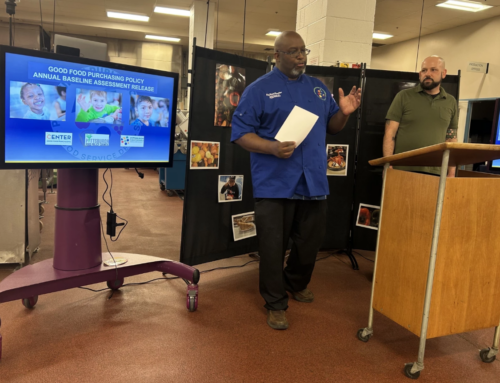In 2017, Cincinnati Public Schools spent more than $7.7 million on food for their kids. That’s $7.7 million of leverage over a food supply chain that runs from farm to factory to cafeteria. Last night, the Cincinnati School Board chose to use that leverage to do some good. By adopting the Good Food Purchasing Policy, the district will direct more of those millions back into the Cincinnati regional economy, creating good jobs that stay in the community, prioritize employer practices that provide workers dignity at work, promote sustainable and humane farming practices, and put healthy, fresh and delicious food in cafeterias for kids to enjoy.
When big public institutions commit to values-based purchasing practices, suppliers have good reason to adopt those values too. The more we spend on suppliers who share our values, the more we strengthen their supply chain, and the more we drive down costs. That makes it easier for other institutions to get on board. The state of Ohio spent $2.1 billion on goods and services in 2016, and just three-fifths went to in-state vendors. Shifting more of that spending to Ohio-based, high road vendors would support an economy that works better for all of us. In absence of values-based purchasing practices at the state level, more local institutions should adopt these innovations.
Ohioans don’t want public policy experiments; we want evidence-based plans that produce real benefits. GFPP fits the bill. Since the Los Angeles Unified School District (LAUSD) started the program in 2012, it has redirected more than $12 million to local fruit and vegetable growers. Los Angeles County has added 150 new well-paying food chain jobs as a direct result of the program, and 160 truck drivers along the district’s food supply chain have seen higher wages and improved working conditions. School lunches now contain less sodium, less high fructose corn syrup, and less red meat, and the district saves nearly 20 million gallons of water each week. Thanks to GFPP, public schools in Austin, Texas now spend nearly half their food budget in-state. The University of Texas at Austin now sources more than 525,000 pounds annually from community gardens and local growers. Cincinnati is part of a growing wave of support for good food purchasing policy: Good Food coalitions are working in Minneapolis-St. Paul, Chicago, Oakland, Washington, New York and San Francisco.
The City of Cincinnati is leading the way on innovative worker protections. In 2016, the city adopted a wage theft ordinance – the first of its kind in Ohio – to ensure workers are paid for all the hours they work. Now, the Cincinnati Public Schools will be a leader in high-road purchasing by adopting the Good Food Purchasing Policy. Policies that encourage healthy food, sustainable development and worker protection are being eroded. Local governments and other anchor institutions like hospital systems, universities and sports arenas have the ability to use procurement as a way to advance smart policy. We applaud Cincinnati Public Schools for their innovative approach and hope more local governments do the same.





